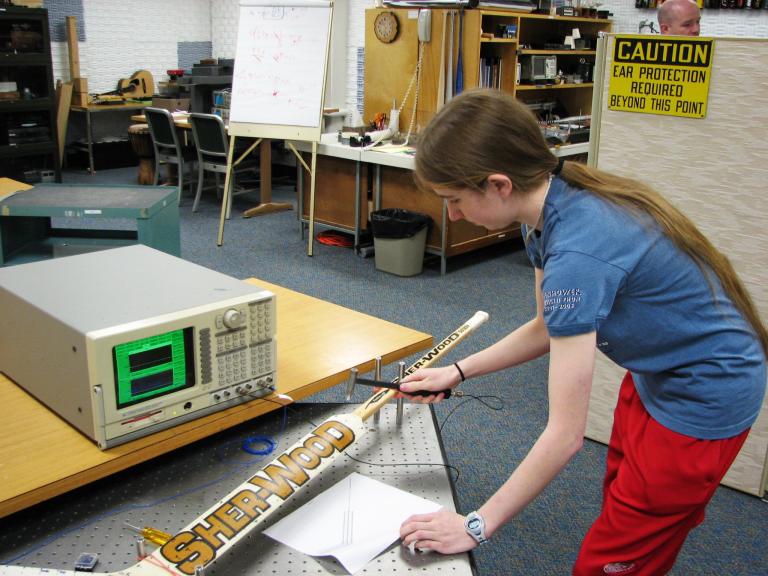
“We’ll study vibration modes of different blades—wood and composite—and hopefully speak with hockey players, perhaps from the Flint Generals and ask them questions about hockey stick performance that might lead us in a specific direction.”
Some old-timers still refuse to get rid of their “twigs.” For them, nothing can replace the feel of a hockey puck on a wood stick.
Maybe they played minor league hockey before face masks were a required piece of equipment. Others might have had a crack at the NHL, back when helmets suggested unmanliness among those who dared to wear them. Years ago, a good two-hander with a wood stick could break wrists, fracture fingers, or cause concussions.
The sport of hockey has changed. Checking a player with his face to the boards from behind is no longer allowed. All players must wear helmets. And one-piece composite sticks, which can produce faster and heavier shots, are the primary choice of players. But alas, even these can break inexplicably and manufacturers have yet to find a process that allows them to last longer than a dozen games during the NHL season.
But one Kettering student wants to know why. Sophomore Linda Hunt of Shelby Township, Mich., recently approached Dr. Dan Russell, associate professor of Physics, about studying the impact of stick vibration on performance. At the time of her query with Russell, she had begun working an on-campus co-op with Dr. Dan Ludwigsen, associate professor of Physics.
The project deals with Helmholtz resonators, which act as acoustic filters or amplifiers. Many automobiles use Helmholtz resonators as part of the intake manifold to filter out particular frequencies from the engine noise. There are standard estimates of the resonance frequency for these devices, based on the geometry of the cavity and the neck—a pop bottle is a classic example. The air in the neck oscillates as a unit of mass and compresses the air in the cavity, which acts like a spring. As a result, if one knows the geometry, predicting the frequency at which the "mass" oscillates on the "spring" is fairly easy. Ludwigsen and Hunt, who majors in Applied Physics and Math, are investigating an improved correction factor, taking into account any sound that exists beyond the opening (in the intake duct, for example). The two are also looking into a possible correction factor for the cavity, related to the springiness of air in the neck as well.
So how does this project relate to the idea of studying hockey sticks?
Physics is the science of matter and energy, and the interactions between the two grouped into traditional fields such as acoustics, optics and mechanics among others. Since a hockey stick is used to shoot a puck, you have matter in the form of the puck and energy in the form of a slap shot movement to fire the puck.
In addition, much of the work on Ludwigsen’s project took place in the Applied Physics Acoustics Laboratory on the second floor of the Academic Building, where Hunt first saw all of the bats used in testing the “sweet” spot. In the corner of the lab stood a hockey stick, which caught Hunt’s eye and eventually prompted her query of Russell about the project idea.
Russell was willing to work with Hunt because the idea sounded interesting and because of her enthusiasm. “This is purely an extracurricular research interest that’s not tied to any class project,” he noted, adding that currently, “we’re at the beginning of the project and don’t have much data to report on yet.”
But, he said, this project, which will span several years during Hunt’s academic career, does have the potential to produce some interesting results.
As a recreational hockey player, Hunt initially wondered if any researchers had conducted studies on hockey sticks to determine why they break the way they do. “Dr. Russell and I did some research and found only a few minor studies on hockey sticks, primarily from a researcher at a university in Montreal,” she explained.
“There really isn’t much available in terms of studies that investigate the vibrational properties of composite and wood hockey sticks,” Russell said. “But the idea of using physics and acoustics to see if we can learn anything useful about hockey sticks is very compelling,” he added.
The initial question the two hope to examine is this: is there anything about how a hockey stick vibrates that influences its overall performance?
“We’re going to take an open-ended approach at first,” Russell said. “We’ll study vibration modes of different blades—wood and composite—and hopefully speak with hockey players, perhaps from the Flint Generals and ask them questions about hockey stick performance that might lead us in a specific direction.”
Overall, Russell and Hunt hope that they achieve important results, which could help stick manufacturers when developing new products for the sport.
And although this project is just beginning, Russell is pleased with Hunt’s desire to study the vibrational properties of sticks.
“It’s nice when a student comes to you and asks if they could talk about a potential research subject, especially when it has nothing to do with their classes,” he said.
As data becomes available, more stories on the progress of this research project will appear on the Kettering website in the approaching months. Get more information about Kettering’s Physics program. Get more information on the Applied Physics Acoustics Laboratory.
Written by Gary J. Erwin
810.762.9538
gerwin@kettering.edu